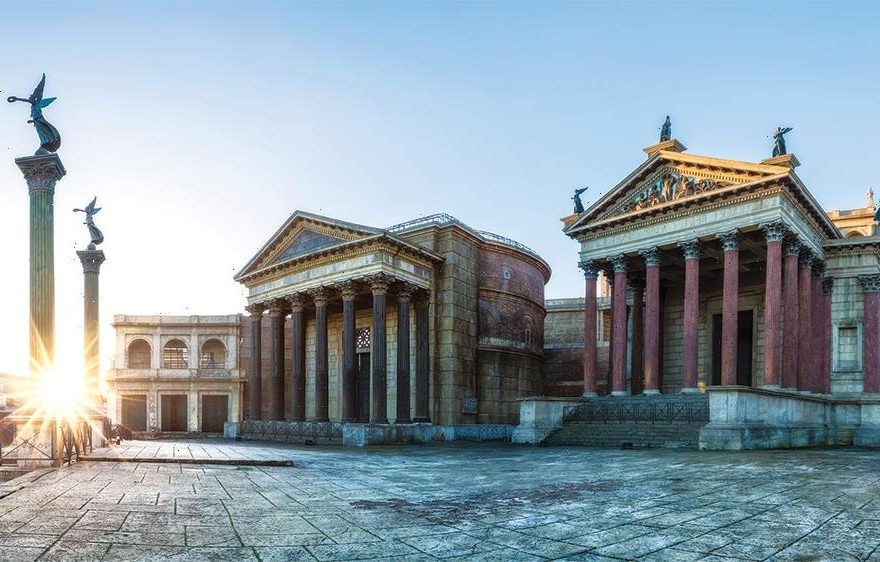Italy’s iconic Cinecittà Studios turn 85 this year and it’s never looked so young.
The famed facilities, which in their Hollywood-on-the-Tiber heyday hosted sword-and-sandals epics such as William Wyler’s “Ben-Hur” and were later home to Federico Fellini, are undergoing a major overhaul that now sees Europe’s largest LED wall situated on the lot near Fellini’s huge Studio 5.
Known as Cinecittà’s T18 Virtual Production Stage, the 412-square-meter (4,434-sq.-ft.) semicircular screen made up of hundreds of high-def displays that serve as interactive backdrops for actors on a smart set, is one of more than a dozen state-of-the art soundstages being built there thanks to a multimillion-euro cash injection provided by the European Union’s post-pandemic recovery fund.
The revamp is being spearheaded by Nicola Maccanico, managing director of Italy’s Istituto Luce-Cinecittà, the state film entity that operates Rome’s expanding Cinecittà Studios. He has ambitions for Cinecittà to become continental Europe’s leading studio facility, plans that involve doubling the size of the studio’s backlot.
In June, European Commission president Ursula von der Leyen and Italian premier Mario Draghi jointly visited the Cinecittà lot and held a press conference in the Studio 5, where Fellini shot almost all of his films, to announce a €300 million ($353 million) investment to “adequately meet the growing international demand for studio space,” as Italian culture minister Dario Franceschini put it.
Cut to less than a year later and Cinecittà, segueing from MGM’s “House of Gucci,” Sky’s ancient Rome skein “Domina” and Showtime series “Ripley,” is hosting several more international projects from Netflix, Amazon, Comcast-owned Sky and also several U.S. studios booked for long-term shoots. Full occupancy has already been reached at the Rome facility.
“Our mandate is to meet the needs of contemporary production and no longer be a place that can attract [productions] for its history, but rather for its present-day value,” says Maccanico, who came on board in April 2021. He notes that the LED wall and the fact that one can now shoot in virtual reality with top technological standards at Cinecittà “has a symbolic significance.” It underlines how Cinecittà is fully up to speed. “In fact, it’s ahead of the curve in terms of its soundstages,” he notes.
Maccanico has been overhauling several of Cinecittà’s existing 19 sound stages and building five new stages on the current Cinecittà lot, as well as an indoor water tank. He has also devised a five-year relaunch and financial plan through 2026 under which the studios are on track to start turning a profit in 2023.
A key aspect of the relaunch being implemented by Maccanico — who underlines that the studios are full-service facilities, with digital editing suites, sound mixing studios and 35mm and 16mm film processing — is to lure big production companies and broadcasters or streamers at Cinecittà with long-term service deals.
That very thing happened in February when Fremantle and Cinecittà inked a five-year pact involving the continuous rental of six soundstages and long-term use of Cinecittà’s services, including costume and prop facilities.
“To fill up studios you need a mix of long-term deals and single sales,” says Maccanico, for whom sealing the Fremantle deal proves that, even prior to the studios’ revamp being completed, “what we already have here today can play a central role within the global production ecosystem.”
For Fremantle, the deal will allow them to plan several productions at Cinecittà, including anti-war feature film “Without Blood,” which Angelina Jolie, who adapted the script from the bestselling novel by Alessandro Baricco, will direct this summer in Italy. Long-term planning for Fremantle means it will be able to manage budgets with less risk and more cost-efficiency.
The company’s choice of Cine-città also reflects the fact that the German-owned giant has become strongly rooted in Italy, where it produces TV series and films through Wildside and the Apartment, the outfits behind TV series “My Brilliant Friend” and “The Young Pope.”
In broader terms, the game-changer for Italy is its tax rebate, which during the pandemic was raised from 30% to 40% of up to 75% of production spend incurred locally and is being kept at that level. It allows producers to get cash back during production, month to month, and reduce costs as they go along.
“House of Gucci” line producer Marco Valerio Pugini says Italy’s generous, no-hassle production incentive is helping to lure more filmmakers from the U.S. and elsewhere, and Cinecittà’s revamp and competitive rates are becoming the clincher to keep them in the country for longer stints. Pugini proudly points out that “Gucci” was entirely shot in Italy in locations including Rome, Milan and Lake Como, though Rome, which also stood in for New York, was the film’s main production site.
“Italy has always been attractive, but what’s happening now is that screenplays are being written for stories meant to be shot here entirely,” says Italian line producer Enzo Sisti, who has been servicing “Ripley,” the Showtime series based at Cinecittà Studios adapted from Patricia Highsmith’s novels by Steven Zaillian, who also directs.
In his drive to give Cinecittà a greater competitive edge against other prominent European facilities such as Germany’s Studio Babelsberg, Hungary’s Origo Studios, and Nu Boyana in Bulgaria, Maccanico last December signed a preliminary agreement with Italian state bank Cassa Depositi e Prestiti to acquire a plot of land adjacent to Cinecittà that will give the studios space to roughly triple the backlot and build eight additional soundstages by 2026.
Looking ahead, Cinecittà is now poised to gain more than 70 acres of land that, once the new soundstages are built, will provide film and TV productions more than 30 acres of additional open-air backlot to shoot on. And adjustments are being made to also become a carbon neutral studio.
“Cinecittà is rapidly gaining lost ground,” says Maccanico, noting that the studios can already “accommodate the needs of all the same clients that are being serviced by other studios in continental Europe.”
“We’ve already become competitive. Now we have to grow.”
Source: Read Full Article
